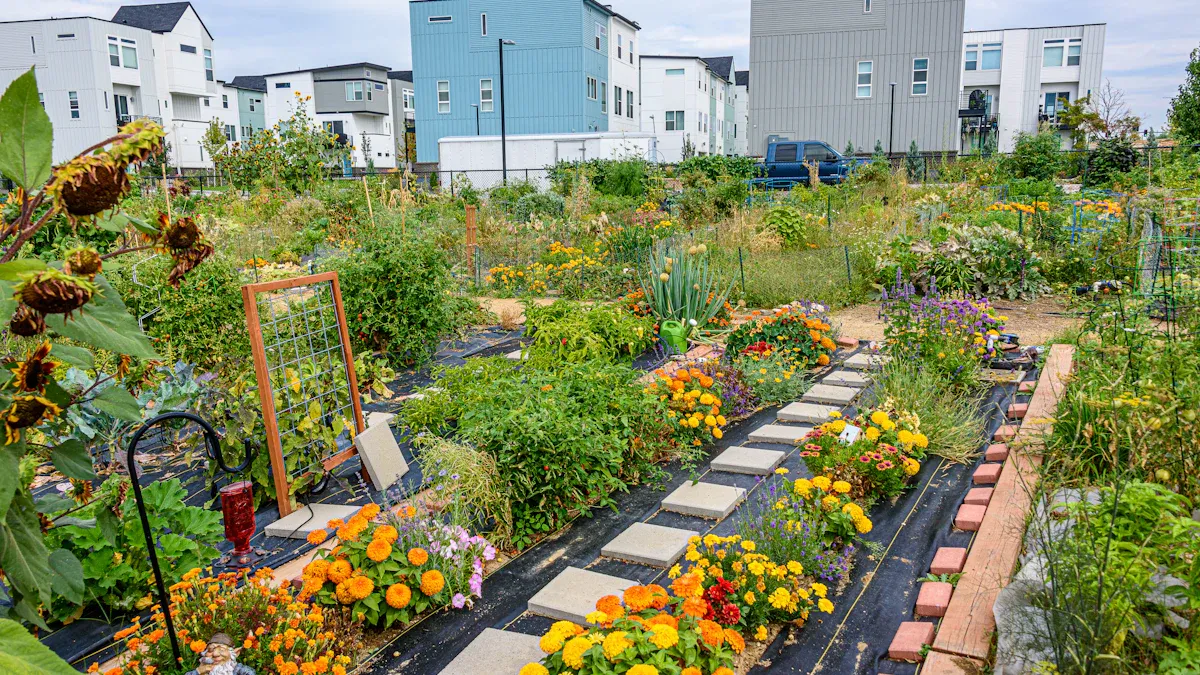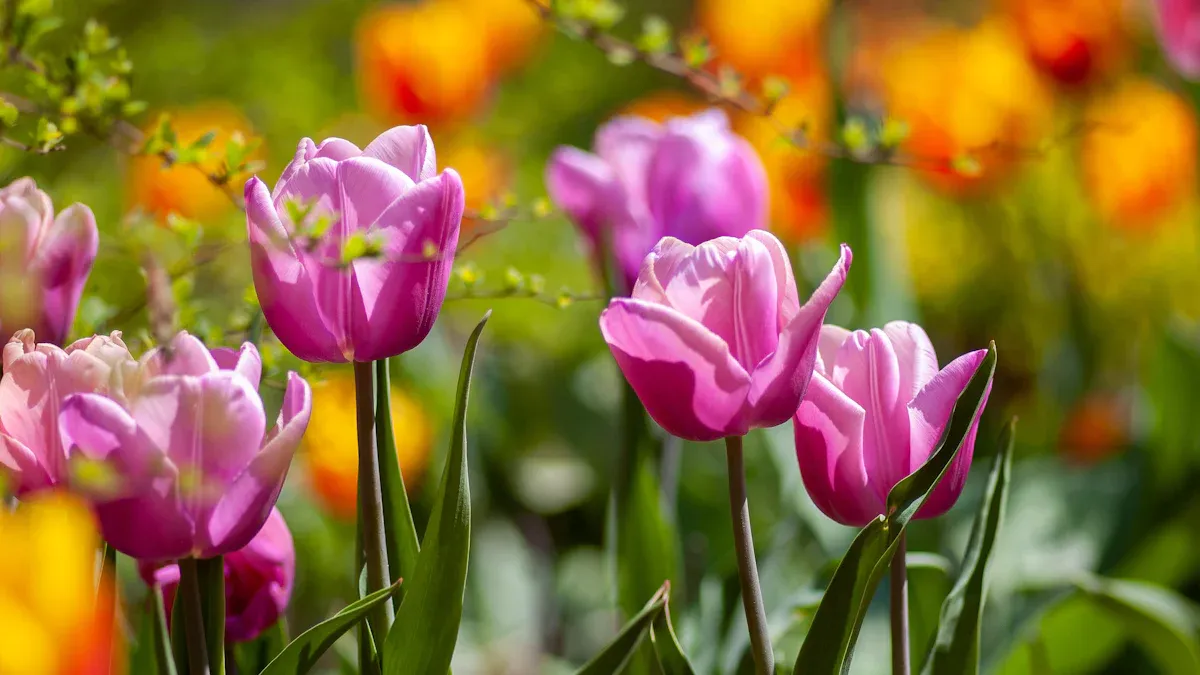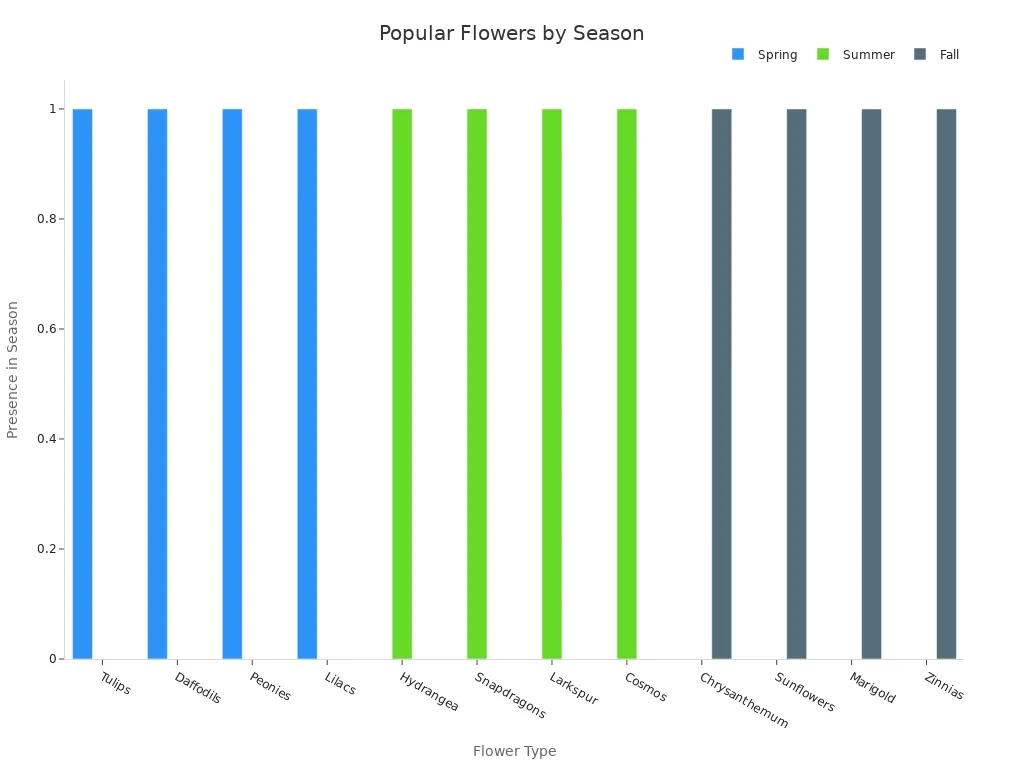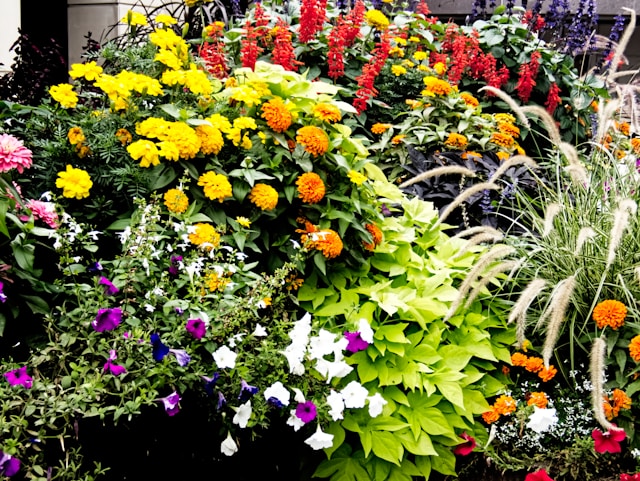Can you spot the difference between annuals and perennials? Here’s a quick tip: annuals bloom for one season, and some drop seeds to grow again next year, while perennials return every year, though some behave like annuals in cold weather. When selecting flowers, consider your event date, favorite colors, and how long you want the flowers to last. For expert flower selection and freshness, trust Nabi Florist in Austin. They create beautiful flower arrangements and offer same-day delivery to ensure your blooms arrive fresh and vibrant.
Key Takeaways
Annuals grow for one season and have bright blooms. Perennials come back every year and get bigger as they grow. Pick flowers by the season to get fresh blooms and good prices. This helps match the mood of your event. Use both annuals and perennials in your garden or bouquet. You get quick color and beauty that lasts. Look at flowers for bright colors, strong stems, and healthy leaves. This helps you know they are fresh before you buy. Nabi Florist makes flower arrangements and delivers the same day in Austin. It is easy to get fresh flowers for any event.
Annuals vs. Perennials

Definitions
When you walk through a garden, you might wonder why some flowers bloom for just one season while others return year after year. The answer lies in the difference between annuals and perennials. Annuals are plants that complete their entire life cycle in one growing season. They sprout from seeds, grow, bloom, produce more seeds, and then die—all within a single year. You get a burst of color, but you need to plant them again next year.
Perennials, on the other hand, are plants that live for more than two years. These flowers come back each spring, often from the same roots or underground parts like bulbs or tubers. Some perennials may lose their leaves or stems in winter, but they regrow when the weather warms up. You can count on them to return, bringing beauty to your garden season after season.
Tip: Some plants act like annuals in cold places, even if they are perennials in warmer climates. Always check your local weather before planting.
Key Characteristics
Let’s break down the main differences between annuals and perennials. This will help you choose the right flowers for your garden or arrangements.
Characteristic | Annuals | Perennials |
|---|---|---|
Lifecycle | Complete their life cycle in one year. | Live for several years, regrowing each spring. |
Growth Habits | Grow quickly and bloom boldly in warm months. | May be evergreen or die back in winter; bloom at different times. |
Maintenance | Need regular watering and sunshine; replant every year. | Need pruning, feeding, and sometimes dividing; less water once established. |
Cost | Usually less expensive; great for changing up your garden each year. | Cost more at first, but last longer and fill out garden beds over time. |
Garden Impact | Give instant color and variety; perfect for seasonal displays. | Provide structure and lasting beauty; can spread and fill space year after year. |
You’ll notice that the characteristics of annuals make them perfect for quick, colorful displays. You can change your garden’s look every year. The characteristics of perennials make them a smart choice if you want flowers that return and grow fuller over time.
Some examples of annuals include petunias, begonias, and marigolds. These flowers grow fast and fill your garden with color. Perennials like hostas, hydrangeas, and peonies come back each year and often need less care once they are established.
Easy Ways to Remember
It’s easy to mix up annuals and perennials, but here are some tricks to help you remember:
Annuals = “A” for “again.” You plant them again every year.
Perennials = “P” for “permanent.” They come back, so you plant them once and enjoy them for years.
Annuals give you a quick splash of color, but perennials build up your garden’s beauty over time.
If you want flowers that last just one season, go for annuals. If you want flowers that return, choose perennials.
🌼 Quick Tip: Mix annuals and perennials in your garden or arrangements. You’ll get the best of both worlds—instant color and lasting blooms!
Blooming Schedule by Season

Spring Blooms
Spring is a time when gardens wake up. Annuals like snapdragons, sweet alyssum, and stock show bright colors early. These flowers like cool weather and smell nice. They also make arrangements look pretty. Perennials such as hellebores, primroses, and lily of the valley bloom in spring too. These flowers come back every year after winter ends. Here are some favorite spring flowers:
Flower Name | Type | Why Choose for Spring? |
|---|---|---|
Snapdragon | Annual | Tall spikes, long-lasting in vases |
Ranunculus | Perennial | Layered petals, showy cut flowers |
Sweet Alyssum | Annual | Fragrant, attracts pollinators |
Hellebore | Perennial | Early bloom, unique foliage |
Primrose | Perennial | Bright colors, easy care |
Spring flowers give you many colors and smells. Annuals can bloom from March to May. Perennials may bloom for weeks or even months.
Summer Blooms
Summer brings hot days and lots of flowers. Annuals like zinnias, vinca, and pentas love the Texas sun. They bloom all summer until frost comes. These are great for summer parties. Perennials such as coneflowers, salvia, and daylilies do well in the heat. Shade-loving annuals like begonias and lobelia add color to cool spots. Perennials like hostas and oak leaf hydrangea give your garden texture.
Perennials for sun: coneflower, salvia, daylily
Annuals for shade: begonias, lobelia
Perennials for shade: hostas, oak leaf hydrangea
When you plan summer flowers, remember annuals are cheaper at first and bloom all season. Perennials cost more but save money later. For big events, annuals give fast, bright color.
Fall Blooms
Fall has strong colors and tough flowers. You can plant annuals like violas, pot marigolds, cosmos, and sunflowers for late color. Zinnias and strawflowers last until frost too. Perennials such as asters, chrysanthemums, and dahlias have bold colors and strong stems.
Viola (annual): Frost-tolerant, bright colors
Pot Marigold (annual): Edible, orange and yellow blooms
Cosmos (annual): Self-sows, autumn shades
Sunflower (annual): Tall, attracts pollinators
Aster (perennial): Purple and blue blooms
Chrysanthemum (perennial): Classic fall flower
Dahlia (perennial): Large, dramatic flowers
Picking flowers like marigolds and chrysanthemums helps your fall arrangements last longer and look fresh.
Winter Blooms
Winter is quiet, but some flowers still bloom in warm places like Austin. Camellias, winter jasmine, and witch hazel are perennials that bloom from late fall to early spring. Pussy willow and mahonia have special blooms and leaves. For annuals, pansies and violas keep blooming in mild winters.
Plant Name | Type | Bloom Time |
|---|---|---|
Camellias | Perennial | Mid-fall to early spring |
Winter Jasmine | Perennial | Winter |
Witch Hazel | Perennial | Fall, winter, spring |
Pansies | Annual | Winter in mild climates |
Violas | Annual | Winter in mild climates |
If you want flowers for winter events, buy them when they are in season. This saves money and gives you the best flowers. Order early and be flexible with your flower choices to stay on budget.
🌸 Tip: Picking flowers that bloom in the right season keeps your arrangements pretty, fresh, and not too expensive for any event.
Year-Round Flower Selection
All-Season Favorites
Some flowers are easy to find all year. This is because flower shops store many kinds in cool places. You can get your favorite flowers any month. Here are some flowers you can always find:
Alstroemeria
Asters
Carnations
Calla lilies
Lilies
Lisianthus
Mums and poms
Spray roses
Sunflowers
Tropicals like anthurium and orchids
Florists also keep greens like ruscus and lemon leaf. These make arrangements look full and interesting. You can trust these flowers to be fresh for any event or gift.
🌻 Tip: Year-round flowers help you plan ahead. You will always have choices for birthdays, anniversaries, or last-minute gifts.
Combining Seasonal and Year-Round Blooms
You can make pretty bouquets by mixing seasonal and year-round flowers. Seasonal flowers add new colors and make your bouquet special. They often last longer and cost less because they are grown nearby. Year-round flowers help fill out your bouquet and keep it looking nice.
Here’s why mixing both is a good idea:
Seasonal flowers show what time of year it is.
Year-round flowers like asters, carnations, and lilies make your bouquet look full.
Greens and fillers like ruscus and baby’s breath add balance.
Mixing both types lets you show your style and save money.
Seasonal Flowers | Year-Round Flowers | Greens & Fillers |
|---|---|---|
Tulips, peonies | Roses, lilies | Ruscus, lemon leaf |
Sunflowers, dahlias | Carnations, mums | Baby’s breath |
Poinsettias, amaryllis | Alstroemeria, asters | Eucalyptus |
When you use both kinds of flowers, your bouquets look bright and last longer. You get flowers that are fresh and always ready.
Flower Selection and Freshness
Identify Fresh Flowers
When you walk into a flower shop, you want the best blooms for your bouquet or event. Flower selection and freshness matter most if you want your flowers to last and look beautiful. You can use a few simple steps to identify fresh flowers every time.
Look at the flowers. Choose ones that stand tall and have bright, lively colors. Avoid any that look wilted or faded.
Check the petals. Healthy petals feel soft and strong. They should not have brown or black spots, bruises, or any strange marks.
Pick flowers with tight or just-opening buds. These last longer than fully open blooms.
Examine the leaves. Healthy leaves look bright green and firm. Skip any with yellowing, holes, or drooping.
Touch the stems. Fresh cut stems feel sturdy and firm, not soft or bendy.
Look at the cut ends. Freshness shows in green or white cut ends, not yellow, brown, or frayed ones. 7. Check for seeds or loose pollen. Flowers with these signs are past their prime.
🌸 Tip: A clean, organized shop with friendly, knowledgeable staff often means better flower quality and care.
Signs of Freshness
You can spot freshness with your eyes and hands. Here are some signs to look for when identifying fresh flowers:
Colors should be rich and vibrant, not faded or dull.
Petals feel supple and bounce back when you touch them. They should not feel dry or brittle.
Stems are strong and do not bend easily.
Buds that are just starting to open will last longer in your vase.
Leaves look bright green and do not sag or have spots.
The base of the stem is clean, not slimy or discolored.
No loose pollen or seeds means the flower is still young.
What to Check | What You Want to See or Feel | What to Avoid |
|---|---|---|
Petals | Soft, colorful, no spots | Brown, black, or bruised |
Stems | Firm, green or white cut ends | Yellow, brown, or frayed |
Leaves | Bright green, firm | Yellow, wilted, or spotted |
Buds | Tight or just opening | Fully open or dropping |
Pollen/Seeds | None visible | Loose pollen or seeds |
If you want a quick freshness test, gently move your fingers under the petals and leaves. Fresh flowers make a faint rustling sound and feel cool and moist.
Storage and Handling
Caring for cut blooms starts as soon as you bring them home. Good care keeps your flowers looking healthy and extends their vase life. Here’s how you can keep flower selection and freshness at their best:
Use a clean vase with no old residue. Pick the right size for your flowers.
Cut about 2 inches off the stems at a 45-degree angle. This helps the flowers drink more water. For some flowers, cut underwater to stop air bubbles.
Fill the vase with room temperature water. Bulb flowers like tulips prefer cooler water.
Remove any leaves that will sit below the waterline. This stops bacteria from growing.
Change the water and clean the vase every day. Re-cut the stems every 2-3 days.
Keep flowers away from direct sunlight, heaters, and fruit. Fruit gives off gas that can make flowers wilt faster.
Use flower food packets if you have them. These help keep water clean and feed your flowers.
If you need to store flowers before arranging, keep them in a fridge set to about 40°F (4°C). Make sure there is no fruit inside.
For short trips, wrap the stems in damp paper towels instead of using a vase.
💧 Note: Trim stems daily and keep water fresh. This simple care step helps your flowers stay healthy and beautiful.
Caring for cut blooms does not have to be hard. With these steps, you can enjoy top quality and freshness for every arrangement. Flower selection and freshness always start with how you identify fresh flowers and how you care for them at home.
Choosing Flowers for Every Occasion
Matching Flowers to Events
Picking flowers for each event helps your bouquet stand out. You want the flowers to fit the mood and meaning. Here are some easy tips to help you:
Bright flowers are great for birthdays. Sunflowers, gerbera daisies, and tulips bring happiness.
Soft colors work best for funerals. Lilies, white roses, and orchids show care and respect.
For weddings, pick flowers with special meanings. Red roses mean love, white roses mean purity, and peonies bring joy.
Think about what the person likes. Some people like bold annuals, others like gentle perennials.
Remember cultural traditions. Some flowers have special meanings in different cultures.
Use color meanings. Purple shows royalty, yellow means cheer, and pink carnations are nice for Mother’s Day.
Add birth month flowers for a personal touch. Carnations for January, violets for February, and daffodils for March are thoughtful.
🌷 Tip: Flowers can say what words cannot. Let your bouquet show your feelings at every event.
Cost and Availability
You want flowers that look nice and fit your budget. The season changes how much flowers cost and how fresh they are. During holidays like Valentine’s Day or Mother’s Day, you find more choices and better flowers. Out-of-season flowers cost more and may not be as fresh. Flower shops have many annuals and perennials, often with better quality and longer vase life.
Season | Flower Type | Cost Range | Freshness Level | Best Use |
|---|---|---|---|---|
Spring | Tulips, peonies | $$ | High | Weddings, birthdays |
Summer | Sunflowers, roses | $ | High | Parties, gifts |
Fall | Marigolds, asters | $-$$ | Medium | Anniversaries |
Winter | Amaryllis, lilies | $$$ | Medium | Holidays, sympathy |
You can save money by picking flowers that are in season. Buying in bulk and shopping at local markets helps you get fresh flowers for less.
Tips for Long-Lasting Arrangements
You want your bouquets to stay fresh and pretty for a long time. Good care helps flowers last longer. Try these simple steps for longer vase life:
Pick flowers when they are cool and full of water.
Take off leaves that will sit in the water.
Cut stems at an angle so they drink better.
Soak flowers in clean water before arranging them.
Cut the stems again before putting them in the vase.
Add flower food to the water for extra help.
Keep flowers in a cool place, away from sun and heat.
Change the water every few days and take out old flowers.
💡 Note: Take care of your flowers every day. Clean water and healthy stems keep your bouquets looking nice and fresh.
Nabi Florist Delivery & Service
Delivery Information
You want your flowers to arrive fresh and on time. Nabi Florist offers same-day delivery if you place your order before 2 pm on weekdays. For Saturday delivery, just order by Friday at 4 pm. This matches the industry standard in Austin, where most florists set their same-day cut-off between noon and 3 pm. You get peace of mind knowing your flowers will arrive quickly for birthdays, anniversaries, or last-minute surprises.
Delivery fees depend on the zip code where you send your flowers. You will see the exact fee before you finish your order. This helps you plan your budget with no surprises. Sometimes, deliveries may be delayed to the next day because of things like weather, busy holidays, or traffic. These delays can happen when there are labor shortages, high demand, or shipping issues. Nabi Florist always works hard to get your flowers delivered as soon as possible.
🌸 Tip: Order early during busy times like Valentine’s Day or Mother’s Day to make sure your flowers arrive on time.
Service Areas
Nabi Florist delivers to many places in and around Austin. You can send flowers to homes, offices, hospitals, and funeral homes. Here are the main areas served:
Austin
Cedar Park
Leander
Pflugerville
Round Rock
Lakeway
West Lake Hills
Tarrytown
Mueller
Nabi Florist covers all these zip codes: 78613, 78641, 78646, 78660, 78664, 78665, 78680, 78681, 78682, 78683, 78701, 78702, 78703, 78705, 78708, 78710, 78717, 78718, 78720, 78722, 78723, 78726, 78727, 78728, 78729, 78730, 78731, 78732, 78734, 78746, 78750, 78751, 78752, 78753, 78754, 78756, 78757, 78758, 78759, 78761, 78766, 78773.
You can also send flowers to all hospitals and funeral homes within these zip codes. This makes it easy to show you care, even if you cannot be there in person.
Contact Details
If you have questions or want to place an order, you can reach Nabi Florist in several ways:
Day | |
|---|---|
Monday | 9:00 AM – 5:00 PM |
Tuesday | 9:00 AM – 5:00 PM |
Wednesday | 9:00 AM – 5:00 PM |
Thursday | 9:00 AM – 5:00 PM |
Friday | 9:00 AM – 5:00 PM |
Saturday | 10:00 AM – 3:00 PM |
Sunday | Closed |
📍 Address: 13201 Ranch Road 620 N, Ste 202, Austin, TX 78717
☎️ Phone: 512-383-5140
📧 Email: support@nabiflorist.com
You can count on Nabi Florist for friendly service and beautiful, fresh flowers delivered right where you need them.
You can tell annuals and perennials apart by how long they live and when they bloom. Annuals grow for one year, then you plant them again next spring. Perennials come back for many years. Annuals bloom for a long time during the season. Perennials bloom for a shorter time and only in certain seasons. Some examples of annuals are marigold, zinnias, and snapdragons. Peonies, roses, and hydrangea are examples of perennials.

Pick flowers that are in season to get the best price and freshness. These tips work for any event, at home or as gifts.
Why choose Nabi Florist?
You get fresh flowers made by experts.
Same-day delivery is quick and easy.
Local florists know which flowers grow well in Austin.
Ordering online is simple and prices are clear.
Nabi Florist can help you celebrate every season. They bring beautiful, fresh flowers right to your door.
FAQ
How do I know if a flower is an annual or a perennial?
You can check the plant tag or ask your florist. Annuals bloom for one season. Perennials come back every year. If you want a quick answer, just remember: annuals need replanting, perennials return.
What flowers last the longest in a vase?
Carnations, alstroemeria, and chrysanthemums last a long time. Roses and lilies also do well if you care for them.
Tip: Change the water every day and trim the stems for the best results!
Can I mix annuals and perennials in one bouquet?
Yes! Mixing both gives you more color and texture. Annuals add bright pops. Perennials bring lasting beauty. Your bouquet will look fuller and stay fresh longer.
Does Nabi Florist deliver to hospitals and funeral homes?
Absolutely. Nabi Florist delivers to all hospitals and funeral homes within their service areas.
You can send flowers for any occasion.
Just provide the correct address and details.
How do I keep my flowers fresh after delivery?
Place your flowers in clean water right away. Trim the stems at an angle. Remove leaves below the water line.
Keep your bouquet away from heat and direct sunlight for the longest vase life.


